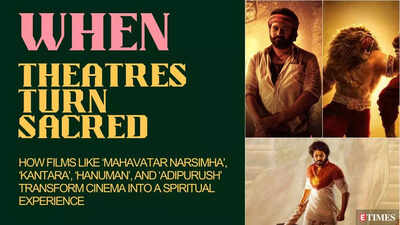ARTICLE AD BOX

When theaters turn sacred: How films like ‘Mahavatar Narsimha,’ ‘Kantara,’ ‘HanuMan,’ and ‘Adipurush’ transform cinema into a spiritual experienceCinema has always been a reflection of human emotion—it can make us laugh, cry, think, and even challenge our beliefs.
But every once in a while, a film does something more. It transcends entertainment, evoking a spiritual connection so profound that theaters themselves feel transformed into temples.The latest example is Mahavatar Narsimha, a mythological spectacle that is not only ruling the box office but also capturing the hearts and minds of audiences across India.
A tradition rooted in the past
This phenomenon isn’t new. In the 1970s, devotional films like Jai Santoshi Maa witnessed unprecedented audience devotion.
People brought flowers, lit incense sticks, performed aartis inside cinema halls, and even distributed prasad. For many, the screenings were as sacred as temple visits.The same tradition has found a modern revival. With Mahavatar Narsimha and other films in this genre, audiences are once again blurring the lines between watching a film and participating in a religious ritual.
The divine pull of ‘Mahavatar Narsimha’
The film narrates the timeless tale of devotee Prahlad and his unwavering faith in Lord Vishnu.
Prahlad’s father, the tyrant king Hiranyakashipu, deems Vishnu his enemy and makes repeated attempts to kill his own son. But as the legend goes, the Lord himself descends in the form of Narsimha—half man, half lion—to protect his devotee and destroy evil.Audiences have been left awestruck, not just by the film’s visual grandeur and animation but by the divine aura it creates. In many theaters, people are removing their shoes before entering, as if stepping into a temple.
Others are chanting mantras and slokas during the climax, their voices echoing in the dark halls.The film’s makers recently shared a heartfelt note on social media, saying:“We are humbled and overwhelmed by the divine response to Mahavatar Narsimha. What began as a cinematic dream has now become a spiritual movement across the country. Theaters have turned into sacred spaces, with devotees performing kirtans, singing aartis, and experiencing a deep connection with Narsimha Dev.
This film was never just a movie; it was a vision to rekindle faith and celebrate our rich spiritual heritage.
Seeing people from all walks of life come together in devotion is the greatest reward we could have imagined.”They further added, “Your love proves that Bharat is ready and eager for stories rooted in our shastras and dharma. This is just the beginning—with your blessings, we will continue to bring such powerful stories to life.”
The ‘Kantara’ phenomenon
Just a couple of years ago, Rishab Shetty’s Kantara created a similar impact. Rooted in the folklore and traditions of coastal Karnataka, the film culminated in a spiritually charged climax that left audiences spellbound. There were even reports of people experiencing trance-like states and feeling “possessed” during the final sequences, a testament to the film’s deep cultural resonance.The film blurred the line between cinema and ritual, proving that when storytelling taps into collective memory and faith, the experience can go far beyond the screen.
The power of ‘HanuMan’
Prashanth Varma’s HanuMan took this divine connection to a new level, blending superhero spectacle with spiritual symbolism. Theaters reverberated with chants of “Jai Shri Ram” and “Jai Hanuman” as the film unfolded, with many viewers describing an “unmatchable energy” they felt while watching.In some places, the screening turned into a collective act of worship, with audience members offering prayers and sharing prasad, just as they would in a temple.Interesting the movie shows how faith is of utmost importance.In an interview with NDTV, Ashwin Kumar clarified that Mahavatar Narsimha is not aimed solely at Hindus, but is meant for people of all faiths. “I’ve had people from various communities, including many Muslim viewers, tell me that the film strengthened their own faith. I’m not asking anyone to convert their religion. What I’m saying is—understand what faith is.
Whether you pray to a God, believe in energy, or place your trust in the universe, this film simply asks you to surrender to that faith,” he explained. Mahavatar Narsimha tells the story of the evil king Hirankashyap, blessed with special layered immunity by Lord Brahma. When he mistreats his son Prahlada, a devoted follower of Lord Vishnu, the deity takes the form of Lord Narsimha to protect the child.However, Kumar insists the film is not “religious” in the conventional sense.
“This is not a religious film—it’s an interfaith film about belief. Love is a universal emotion, and so is faith. That’s why the film is growing in leaps and bounds,” he said.
When the divine shows up in real life
In the case of Adipurush, the mythology seemed to spill into the real world when a monkey—considered sacred in Hindu tradition—unexpectedly appeared during filming. For many, it felt like a sign of divine blessing, adding to the film’s spiritual aura even before its release.
Shiva Rajkumar Reactions After Watching HanuMan Movie | Teja Sajja | prasanth varma
When cinema becomes faith
These films show that cinema has the power to be more than just entertainment. It can be a spiritual awakening, a communal act of devotion, and a reminder of the cultural and religious threads that bind people together.In such moments, the theater ceases to be just a building with a screen—it becomes a sanctum, a place where stories are not only watched but also worshipped.And perhaps that is the true magic of cinema: its ability to move people so deeply that they forget they are watching fiction and instead feel they are in the presence of the divine.



.png)
.png)
.png)
















 2 hours ago
4
2 hours ago
4









 English (US) ·
English (US) ·